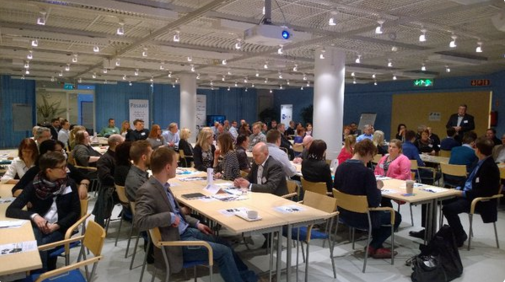Making the most of your time, when working alongside other projects
Successful Project 2016 / Onnistunut projekti 2016- event in Tampere pondered current topics like this: How to make (digitalization)projects more successful? To ponder:
- How has your project activity improved lately?
- What areas of development do you recognize in your own organization/work?
We went through the questions in three groups and around 30 participants.

Picture: At the workshop
The first, and a little worrying observation was, that project activity had not improved much lately. “This is how we’ve always done it”, “Maybe it has gotten a little bit easier…” were the most common comments.
Let’s think about this in a form of a question: What areas need development in your own organization/work?
Areas for development were:
- Product owner’s – client’s / end user’s stronger role in projects
- Investing more in project activity – not just the 5-50 % alongside one’s own work
- Management
- Communication and collaboration
Project client’s / owner’s participation in the project
Two out of three groups pointed out the client’s participation in a project as an area for development, and this is something I want to note too. The experience was that the project owner or product owner is not investing enough on the projects. The project is commissioned and benefits are pursued one way or another, but participation in project execution is inadequate. This sounds strange, but to participants’, and my experience, very common.
Next, as an area for development, there was investing in the project activity. This mostly explains why the client’s role is too weak.
Efficient use of time, when working with projects alongside your own work
Projects are usually worked on alongside one’s own work and the chance to invest in a project is limited to for example 5-50 % of work time. Unfortunately, this will not change. Time is always limited. The point is, how the time is used.
When the time to participate in a project is limited, the time has to be spent efficiently. This becomes a challenge for the project manager but also for managing project activity in general. How to prioritize the use of resources, who gets the resources and when?
The most important part is that the resources are reserved for 100% in the critical moments of the project, and are given peace to work on it. If the resource has approximately one day in a week to work on the project, it’s easier to reserve a certain day for that, other than randomly answer emails and sit in meetings.
Recognizing project’s critical phases
Project’s critical phases can be found anywhere from specification, testing or scheduling. The most important part is, that in the critical phase, all the resources are reserved, gotten and given absolute peace to concentrate on the project. Phones on mute, out of office-message on emails and a 100% participation.
When the critical phases are recognized and resources reserved, managing the project’s other work and communication gets easier. No extra time is being spent, only the use of time gets more efficient.
Let’s communicate
Let’s tell the project owner that the resources are needed for the critical parts and let’s decide on the schedule on time. Let’s think about who the key persons are and make sure they are available, both physically and mentally. When we do it like this, working with projects alongside our own work is more enjoyable, more sufficient and the projects more successful.
Download eBook Business Critical Project Running?
Download a guide on software testing in development projects. You’ll avoid many common mistakes and succeed in the implementation.
Did you know?
Quality Gate is a user friendly tool for software development and testing projects
Improved testing efficiency, 70% less emails and real time reporting
Read more
Roadmap is a user friendly software for development projects
Easily plan and execute even the most challenging development project
Read more

